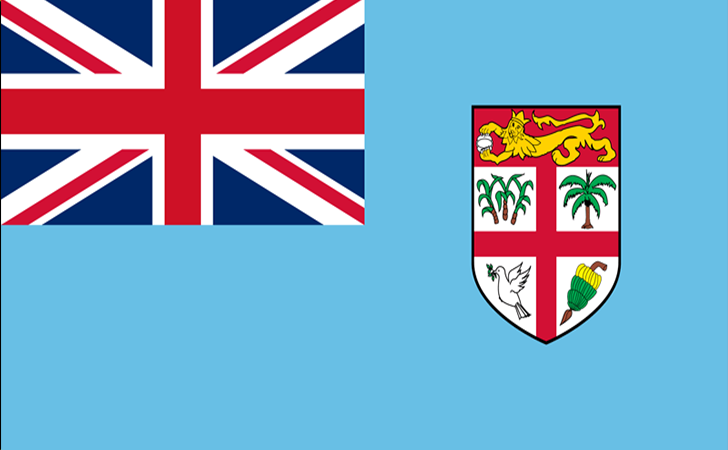
The national flag of Fiji was approved on 10 October 1970. The state arms have been somewhat adapted but the Fiji Flag has continued the same as throughout Fiji's colonial period. It is a spoiled sky-blue "Blue Ensign". It has remained unaffected since Fiji was professed a republic in 1987, despite calls from some politicians for variations. A plan to change the flag, proclaimed by Prime Minister Frank Bainimarama in 2013, was abandoned in August 2016.
The flag's positive blue contextual symbolizes the Pacific Ocean, which plays a significant part in the lives of the dwellers, both in terms of the fishing industry, and the huge traveler trade. The Union Jack reproduces the country's links with the United Kingdom. Flag of Fiji shield is derived from the nation’s coat of arms that granted by Royal Warrant in 1908. It is a white armor with a red cross and a red chief.
A self-governing kingdom prior to flattering a British colony in 1874, Fiji momentarily used a national flag of white and blue vertical bands with a red central armor bearing a white dove. That sign was derived from the flags of Christian priests who had visited the area. Under British rule the normal flags were presented—the Union Jack for government buildings, the British Red Ensign for secluded vessels, and the British Blue Ensign for government vessels.
The only changes announced when the nation became independent on October 10, 1970, were the replacement of light blue for dark in the field of the flag and the omission of the crown, motto, and groups in the coat of arms, allowing the shield to be larger and more effortlessly visible.
The flag's blue field is represents the surrounding Pacific Ocean. The coat of arms show a golden British lion holding a cocoa pod, as well as panels showing a palm tree, sugar cane, bananas and dove of peace.
Fiji is an officially Republic and an island country in Melanesia, and includes a part of Oceania in the South Pacific Ocean. The islands is closet to , and Tuvalu to the north, New Caledonia to the southwest, New Zealand's Kermadec Islands to the southeast, Tonga to the east, Vanuatu to the west, and the Samoas and France's Wallis and Futuna to the northeast. The population of Fiji is 9.06 lacs, and has the population density of 46 people per square kilometer (120/square mile).
Fiji is a multiparty system with the Prime Minister of Fiji as head of government. The official language of Fiji is Hindi, Fijian and English and the currency is Fijian Dollar. Fiji comprises of two letters Fiji code i.e. FJ and its three letters Fiji code is FJI and in digits it is 242. The calling code is +679 and the UTC i.e. standard time followed in Fiji is UTC +12 hours.
Being a multiparty system, Fiji comprises a total of twelve administrative districts instead of provinces.
| Country | Fiji |
|---|---|
| Continent | Oceania |
| Official languages | English, Fijian, Hindi |
| Capital | Suva |
| Currency | Fijian dollar $ (FJD) |
| Australia | Australia Flag |
| Fiji | Fiji Flag |
| Kiribati | Kiribati Flag |
| Marshall Islands | Marshall Islands Flag |
| Micronesia | Micronesia Flag |
| Nauru | Nauru Flag |
| New Zealand | New Zealand Flag |
| Palau | Palau Flag |
| Papua New Guinea | Papua New Guinea Flag |
| Samoa | Samoa Flag |
| Solomon Islands | Solomon Islands Flag |
| Tonga | Tonga Flag |
| Tuvalu | Tuvalu Flag |
| Vanuatu | Vanuatu Flag |
| CET | UTC+12:00 |
|---|---|
| CEST | UTC+12:00 |
| Internet TLD | FJ |
|---|---|
| Three-letter country code | FJI |
| Three-digit country code | 242 |
| Calling code | +679 |